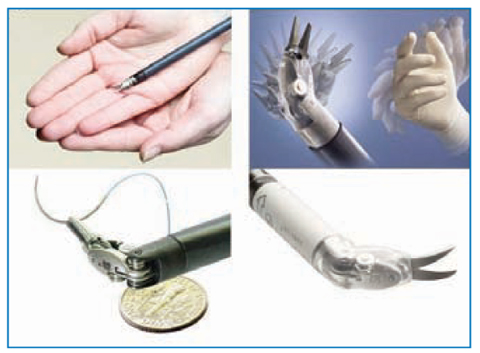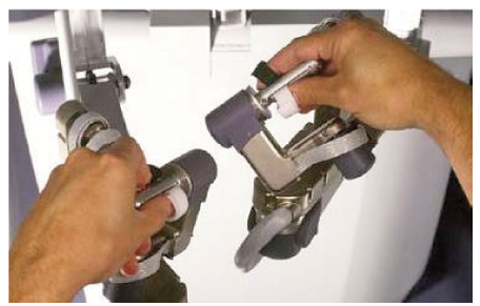Fig. 15.1
The da VinciTM robotic system (courtesy of Surgical Intuitive, Inc., Sunnyvale, CA, USA)
Instruments
EndoWrist instruments are designed to provide surgeons with natural dexterity and a full range of motion for precise operation through tiny incisions. EndoWrist instruments provide enhanced dexterity thanks to a great range of motion that allows precision and control. The features of the instruments are: seven degrees of freedom, 90° of articulation, intuitive motion and fingertip control, motion scaling and tremor reduction (Fig. 15.2).


Fig. 15.2
EndoWrist (courtesy of Surgical Intuitive, Inc., Sunnyvale, CA, USA)
Dual-console surgical system
The newly refined da Vinci Si Surgical System includes a dual console used for training and collaboration. During a dual-console operation, each surgeon sits at his/her individual console and can see the same high-definition images of the anatomy from the 3D endoscope (flexible tube with a camera and light at the tip). If the dual console is used for training, control over instruments can be readily and quickly exchanged during surgery. Hence, the tutor surgeon can handover control of the instruments to the resident at any time. This enables a see-and-repeat model of instruction designed to accelerate the learning curve. For collaborative surgery with the dual console, two surgeons can operate in concert. While one surgeon undertakes the primary tasks of the procedure, the second surgeon can assist with another task (e.g., retraction) (Fig. 15.3).


Fig. 15.3
The da Vinci dual-console surgical system (Master Handles) (courtesy of Surgical Intuitive, Inc., Sunnyvale, CA, USA)
Procedures
Currently, the indications for robotic lobectomy are strictly defined: patients must be in clinical stage I with a negative mediastinoscopy and without evidence of other pulmonary lesions on CT. This method is not recommended for tumors >4 cm because the ribs have to be spread excessively to retrieve the specimen. Single-lung ventilation is required. The general standards of monitoring are as for a major thoracotomy. Patients are prepared and draped for a thoracotomy (posterolateral thoracotomy) with the operating table flexed at 30° at the level of the scapula tip so that the procedure can be converted in the event of intraoperative complications such as bleeding or for technical reasons. Insufflation of low-pressure of carbon dioxide (5–8 mmHg) into the pleural cavity can be useful to facilitate lung collapse and wash out intrapleural smoke. Robotic lobectomy follows the standard steps of open thoracic surgery and implies the isolation and resection of the vascular and bronchial hilar elements. Usually, the artery is dealt with before the vein and eventually the bronchus is transacted, but priorities are not set strictly. Robotic technology has added certain advantages in minimally invasive thoracic surgery for anatomic lung resection (especially pulmonary lobectomy). Minimally invasive lobectomy for early-stage lung cancer is entering daily clinical practice. In part it is due to the detection of lung cancer at smaller sizes thanks to screening programs. In part it is due to advances in minimally invasive technology, with the development of robotic systems. Only a few robotic lobectomies have been carried out. Consequently, few surgeons have experience in this field.
Stay updated, free articles. Join our Telegram channel

Full access? Get Clinical Tree






